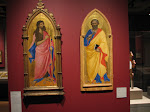



Angela Thigpen
AH 251
March 7, 2009
Bruce Museum
The Bruce Museum is located in Greenwich, Connecticut, and was a private home until the early 1900s when Robert Bruce the owner willed the home to the Town of Greenwich with the stipulation that it be made available to the public, and used as a Natural History and Art Museum. The Museum is set upon a hill, and has a very tranquil yet distinguished atmosphere.
Visiting the Bruce Museum in Greenwich gave me an opportunity to ponder many things as I viewed the environmental, historical, and modern exhibits: As I viewed the environmental exhibits I was able to appreciate earth and all the beauty and resources that were created for each inhabitant, not only man, but animals and those living in the air and sea. I also came to comprehend in greater depth how truly connected and dependent we are upon each other. Planet earth is about 4.55 billion years old, and man is in a sense the preserver or keeper of earth. The earth is filled with countless minerals and natural resources, many of which were on display. I also viewed the taxidermy exhibit featuring a red fox, American eagle, and beaver, just to name a few and learned how they lived and occupied the beautiful landscape. There was one of the first typewriters on display, as well as apparatus cobblers used to make shoes.
I also viewed a private collection of Modern Art, and was impressed with the exhibits: the first display was a sculpture entitled the Cement Worker by Duane Hanson, 1925-1996. Hanson was an American sculptor who held a degree in Art from Macalaster College in St. Paul, MN, and a MFA from Cranbrook Academy of Art in Bloomfield Hills, MI. Hanson moved to West Germany in the early 1950s, and taught Art, and later relocated to Munich working as a sculptor in many media outlets. The medium was polyester and fiberglass, poly-chromed in oil with accessories. The Cement Worker was about the height of the average man, and was dressed like the typical man in the early 1970s in blue jeans, a plaid shirt, and natural hair, and appeared to be leaving the construction site after a long work day.
The next Modern exhibit was entitled the New Barbarians by Tim Noble and Sue Webster; Noble 1966, Webster 1967. Noble was born in Stroud UK, and Webster was born in Leicester UK. Both artists hold Degrees in Fine Art from Nottingham Polytechnic, and met while studying there. Noble and Webster are life partners as well as professional partners. The sculpture New Barbarians is a self portrait of the artists as Neanderthals. Although this couple appears naked and shorter than the average man and woman there was much talent and skill placed in this amazing work of art. The medium is fiberglass and translucent resin. The naked couple appear oblivious and without fear: the male and female’s facial features; eyes, nose, mouth, and ears are perfectly crafted. The skin appears lifelike, the veins appearing in the arms, the fingers and toes, rib cage and navel, breast and nipples, penis and scrotum. This display left me in awe.
The center of the Bruce Museum displayed the Setting the Stage: Twentieth Century Theater Model winning exhibits. The model that I was able to photograph was Mario Sala’s set model for Carmen, 1914, at the Metropolitan Opera in New York, made of paper and mixed media. The winning selections chosen for display, and are used to help plan and design the stage for Broadway plays. Mario Sala was born in Winterthur, Switzerland in 1965, and currently works and resides there.





